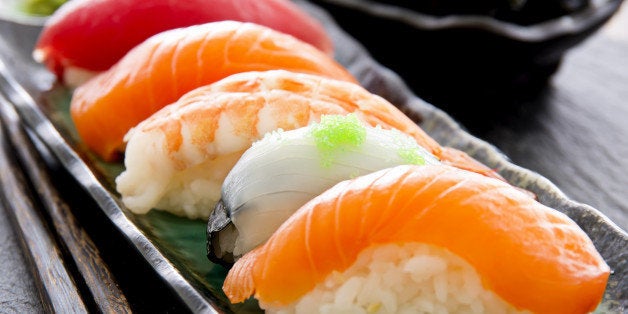
A study of sushi eaters in New Jersey shows just how much sushi people are eating (and who's eating it) -- as well as which kinds of sushi may expose people to the highest levels of methylmercury.
Researchers from Rutgers University and the Robert Wood Johnson Medical School examined sushi consumption among 1,289 people who lived in a New Jersey university community, as well as levels of mercury among samples of sushi taken from stores and supermarkets in New Jersey, New York City and Chicago. Of the people surveyed in the study, 92 percent said they ate fish, consuming an average of five fish or sushi meals each month. Seventy-seven percent of the respondents said they ate sushi, averaging 3.27 sushi meals a month. The amount of fish in pieces of sushi consumed by the study participants ranged from 5 to 25 grams.
Among the findings of the Journal of Risk Research study:
- Caucasians and Asians (particularly East Asians, compared with South Asians) reported eating the most sushi. Some people surveyed in the study reported eating more than 40 pieces of sushi a month, and eight of the people in the study said they ate fish or sushi at least once a day.
- The top 10 percent of sushi-eaters exceeded the Center for Disease Control Minimal Risk Level and the WHO Provisional Tolerable Weekly Intake for methylmercury consumption. (People in this group ate sushi for an average of 30 to 60 meals each month.)
- The type of sushi with the highest average levels of methylmercury was tuna sashimi (with about 0.61 parts per million of methylmercury).
- Levels of mercury varied between sushi samples, "with some levels as high as 2.0 ppm [parts per million], which makes exposure to mercury from consumption of sushi (or sashimi) less predictable."
- Atlantic bluefin and bigeye tuna are particularly high in methylmercury.
- Eel, crab, salmon and kelp sushi had lower levels of methylmercury.
"The risk communication message is becoming increasingly clear. For people who eat fish or fish-sushi infrequently (less than monthly), the choice of which fish to eat regarding mercury content is probably not important," the researchers wrote in the study. "People who eat fish frequently, more than weekly, must choose wisely. High-end sushi eaters should minimize intake of tuna."
While methylmercury is hard to avoid completely -- everybody has some amount of it in their tissues, due to its prevalence in our environment and the consumption of seafood -- it can be dangerous, depending on a number of factors (such as dose, age of exposure, and duration and route of exposure). The Environmental Protection Agency points out that methylmercury can be especially dangerous for fetuses, infants and children, as it can impair neurological development (which is why pregnant women are discouraged from eating methylmercury-containing fish and shellfish). However, the EPA also pointed out that a 1999 and 2000 report from the Centers for Disease Control and Prevention showed that most people don't have mercury levels high enough in their blood to cause health effects.
For a list of seafood that is highest and lowest in mercury, check out the Natural Resources Defense Council's list here. And if you want to see the mercury levels of your seafood while on-the-go, The New York Times reported on a smartphone app, called Safe Sushi, that indicates the mercury levels of 38 varieties of seafood.
The findings on mercury levels in bigeye and bluefin tuna fall in line with a 2010 study in the journal Biology Letters, which showed that these kinds of tuna -- which are more commonly served at restaurants -- have higher levels of mercury than species you could buy at grocery stores, LiveScience reported. That study involved using DNA barcoding to examine mercury levels among different kinds of tuna species from sushi samples taken from 54 restaurants and 15 supermarkets. The researchers found in that study that yellowfin and bluefin toro (fatty tuna) had lower levels of mercury, compared with the bluefin akami and bigeye tuna.
In addition, an investigation conducted by the Milwaukee-Wisconsin Journal Sentinel in 2008 examined 10 samples of sushi from three restaurants and a grocery store, and found that two of the pieces of tuna had extremely high mercury levels, while the shrimp, salmon and mackerel sushi samples had just "trace amounts" of mercury. The Journal-Sentinel's Raquel Rutledge reported:
A 130-pound person who ate 8 ounces (about six to eight pieces) of either tuna sampled by P.I. [the newspaper's Public Investigator team] would exceed the U.S. Environmental Protection Agency's standard -- or suggested maximum daily intake of methyl mercury -- by more than 35 times.
It's not just sushi eaters who should be aware of mercury in fish. In 2011, Consumer Reports released an examination of mercury levels in canned tuna, showing that white, or albacore, tuna is higher in mercury than light tuna. However, all of the 42 samples tested by Consumer Reports had some level of mercury, ranging from 0.018 parts per million to 0.774 parts per million.
A report released earlier this year by University of Bristol researchers showed that fish may only be responsible for 7 percent of dietary mercury in humans, TIME pointed out. In addition to fish, tea and alcohol seemed to be the next-biggest culprits for mercury contamination.
